A simple Tesla music coil
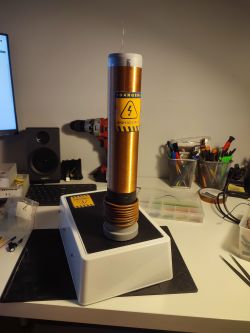
Hello
I've always wanted to build a musical tesla coil, but I was overwhelmed by the complexity of the design schematics found on the internet. Some time ago I found a schematic of a single transistor based coil and decided to improve it so that it could play sound. I decided to share the project so that others could make such a simple coil.
Here is the diagram I found:

The effect of her work was poor, no spark, only the fluorescent lamps were getting closer to light. I increased the number of windings to 5 on the primary (I made them from a 1.5 mm? cable
The next step was to make the coil play. I used ESP8266 (it was handy, and I had code for arduino on the disk that plays simple tunes). ESP generates a square wave with a given frequency, which controls the unipolar transistor (2N7000), short-circuiting the bases of the transistors controlling the coil to ground. In this way, we managed to get a nice and loud sound from the coil.
Finally, I made a casing from some IKEA box that happened to be at home. As a power supply I used a 36 V impulse power supply (LRS-100-36, I had it from some electro-scrap that I got as a "gift" for parts), I reduced its voltage to 30 V with the potentiometer on it.
I know that the scheme has some shortcomings, it was just created as much as my knowledge allowed, there is definitely something to be improved in it. It is as follows:

I soldered everything temporarily on a universal board, there are plans to make a printed circuit board.
Unfortunately, I didn't take photos during the creation, but I put in those with the coil ready.

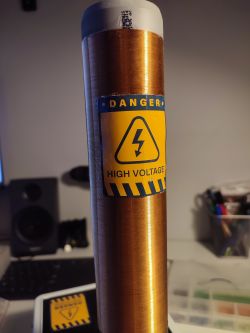

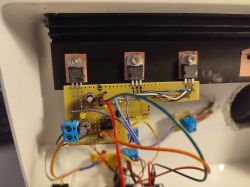

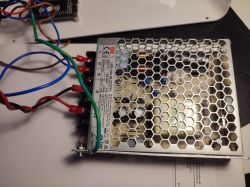
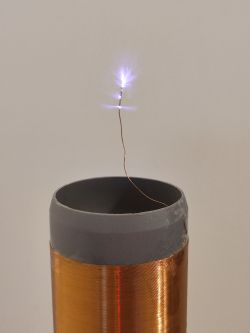
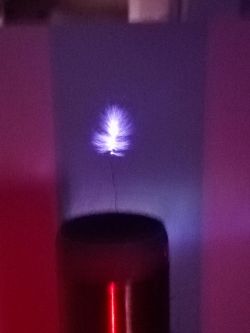
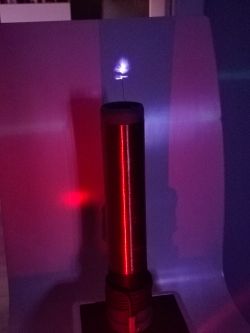
1st movie:
Program code for ESP8266 (written in Arduino IDE) I attach to the topic. ESP provides a page on the local network where you can select a track to play. I add a second program that works immediately after startup (it does not connect via Wi-Fi, only plays one track in a circle).
Regards
PS.
It should be noted that the Tesla transformer generates a high voltage of several kilovolts, so be especially careful when working!



Comments
Have you checked the frequency of work? As it goes in hundreds of kHz or even MHz, you could try something similar to a class D amplifier and then even normal mp3 would play. Kind of like my HFVTTC link... [Read more]
Unfortunately, I do not have an oscilloscope or even a multimeter with frequency measurement. I also do not know how to check or calculate this frequency in another way :( Does such a coil emit radio frequency... [Read more]
Yes, the Tesla coil is essentially a radio transmitter. A well-tuned one should generate radio waves with a length equal to the length of the wire on the secondary winding. A less tuned one will transmit... [Read more]
Then let me look for that frequency in a moment. I have an SDR with the R820T2 chip and it reaches up to 1864 MHz. [Read more]
Rather, you have to look at the lower range, that is, a single MHz. Even if you catch something, you cannot be 100% sure of this frequency, because it may be one of the next harmonics. [Read more]
I rummaged through the manual and it turned out that my SDR ranges from 0.1 MHz to 1.7 GHz (it was enough to change the settings). The coil emits a strong wave at 1.037 MHz, if it's playing a song,... [Read more]
Not true, the resonant circuit is inductance and capacitance, not the length of the wire. [Read more]
Yes, but a well-calculated Tesla coil has a resonant frequency equal to that of a wire-length wavelength on the secondary winding. This is why toruses are used to vary the resonant frequency to tune this... [Read more]
equal to inductance and inter-winding capacitance. that someone also wanted to look for such a relationship :) normally no one is concerned with such dependencies. Anyway, the author has too high... [Read more]
Well, someone found it and everyone who wants to have good results applies to this dependence. [Read more]
Every radio amateur will tell you that the best amplifier is the antenna, and by choosing its dimensions and the length of the wire, you tune it. And wasn't the length of the wire 1/4 or 3/4 of the... [Read more]
From what I remember it was 1 or 1/2 wavelength. I have to look for an email from a man who did something about 40 cm of arc on VTTV on GU81. [Read more]
If someone has a pacemaker, a heart defect, a disturbed potassium-sodium balance, or some other heart conductivity problem, such a coil is very dangerous. At best, a healthy person can burn, but I still... [Read more]
Epidermis, read how much it is at 1 MHz. But the coil is not an antenna. [Read more]
I would be more tempted to use the term Tesla's generator or transformer, not "coil"; Second thing, the Tesla generator is tuned with the primary winding, not the secondary one. The third thing, the... [Read more]
What about the electromagnetic field? It seems to me that the starter is shielded in some way and the risk is minimal, but I wonder if anyone knows anything more about it. I even remember in high school,... [Read more]
As @ rosomak19 wrote, it can be considered a quarter-wave plate, but for proper resonance it needs to be tuned with a suitable capacitor, e.g. a torus. Finally, tune the resonance in the primary circuit. ... [Read more]
I do not know about your musical Tesla, but with my classic one, the field was so strong that the fluorescent lamp in my hand shone from a long distance. I do not know about the starter, but the phone... [Read more]
I would be more afraid of nitrogen oxides than ozone. It was one of the first industrial methods of producing nitrogen oxides and then nitric acid. An electric arc in the air, later refined by the addition... [Read more]